Viewpoint | Witnessing History: Global interest rate cuts will give birth to Bitcoin's elder bull
Author: BlockVC
Editor's Note: The original title was "Half, Water, and the Bitcoin Bull"
Emergency rate cuts and global water releases
Choose the Lesser of Two Evils
Living in an age that is constantly witnessing history, I don't know if it should be counted as a lucky or unfortunate thing. In other words, the real historical turn is always silent. When you are aware of it, the great changes of the times are already on your head.
On March 3, 2020, we may have witnessed history again in a daze. The Fed announced a sudden emergency rate cut of 50BP at a non-interest rate meeting after 12 years . Since 1994, there have been 9 emergency rate cuts in the history of the Federal Reserve The last emergency interest rate cut dates back to the October 2008 economic crisis.
- ING economist: If the dollar does not go digital, it will fall out of favor
- BitMEX follow-up impact, UK strengthens supervision of cryptocurrency exchanges
- Introduction | tBTC: A New Bitcoin Sidechain Design
If you have no concept of the historical significance of emergency rate cuts, you can take a look at the time of previous emergency rate cuts, including the 2008 subprime mortgage crisis, economic recession, and the collapse of Lehman Brothers. After the bursting of the stock bubble and the 1998 Russian financial crisis and the collapse of long-term capital management companies, etc., each emergency rate cut is a huge wealth shuffle and a memorable event that is enough to be recorded in global economic history. Such a level of historical events is It just happened on the eve, and it will also be recorded in the history of the global economy.

Data source: Federal Reserve
This emergency rate cut is also the Federal Reserve ’s response to the rapid spread of the New Crown epidemic after the People ’s Bank of China. In the past two years, we have imagined the possibility of numerous US stock market crashes and global stock disasters, or corporate sector leverage, or The ETF liquidity crisis, or the fundamentals turned into recession, failed to predict everything but was kicked off by a virus epidemic sweeping the globe.
In the last week, major US stock indexes have fallen violently. US stocks have suffered the largest weekly sell-off in ten years. The Dow Jones Industrial Index (down 12.4%), the Nasdaq index fell 10.5%, the S & P 500 index fell 11.5%, and the panic rate index VIX has soared to the 99% quantile level since July 2014 . Affected by the rapid spread of the global epidemic and concerns about supply cuts in the global supply chain, stock markets in Japan, South Korea, Italy, and other countries in the hardest hit areas led the decline in the Asia-Pacific and European markets. Commodity markets are also hard to escape. The crude oil market has seen its biggest weekly decline in 10 years. Even the recognized safe-haven asset gold has been suppressed and sold by institutions to make up for the equity market margin.
Because of the record-level decline in U.S. stocks, the Fed's emergency interest rate cut is naturally anxious to continue for ten years. Just as the importance of real estate to the wealth of Chinese residents, the financial assets represented by stocks account for nearly 70% of the total assets of the U.S. resident sector. At this moment, the proportion of net financial assets of the U.S. residents to disposable income is at a historically high level , and this part The rise in assets comes entirely from monetary easing and rising asset prices. Therefore, the severe adjustment of the US stock market will severely impact residents' balance sheets and consumption, which is by no means an scene that Americans would like to see.
After the U.S. Federal Reserve announced an emergency interest rate cut, Japan, Canada, Australia and other central banks quickly followed. The probability of a rate cut by the European Central Bank and the Bank of England has soared. use all appropriate policy) to hedge the downside risks, the global "water release game" seems to start.
If you calm down temporarily, you can find that most of the Federal Reserve ’s emergency rate cuts in the past three decades have occurred during the recession or are about to begin a recession, and once the rate cut begins, it will inevitably trigger a continuous rate cut (the market ’s pricing for the probability of continued rate cuts within 6 months has been as high as 77% or more).
The most direct impact of the Fed's rate cut is the depreciation of the US dollar, the rise in U.S. debt, and the short-term repair of stocks, but the increased volatility. Not to mention whether the depreciation of the US dollar and the decline in interest rates will lead to a large number of capital flight, only the Dow Jones Index and the S & P Index after the previous rate cut From the performance point of view-the emergency rate cut seems to mean that everything has just begun, and the decline in the first quarter of profits has added pressure on the continued adjustment of U.S. stocks. Except for 1998, after the emergency rate cuts, the U.S. stock market fell inertia in the following 6 months. It hit a new low, which can not help but worry many investors whether the Fed has started to sound the alarm for the upcoming recession.

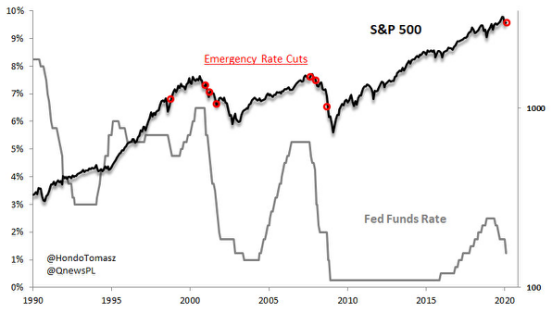
Data source: Bloomberg Internet
Cutting interest rates is only the appetizer, QE is the big meal
The behavior of central banks in the world this time is essentially the same as writing "answers" and copying a bunch of formulas on the last big question of college entrance examination mathematics. The main purpose of central banks in various countries is to maintain bond spreads. 2. Maintain exchange rate stability. Second, support the real economy and maintain financial market stability.
The yield on the US 10-year Treasury bond officially fell below 1% historically , which caused the last 100bp careers of many bond traders to be pierced. Japan and Europe are stuck in “negative interest rates” for a long time, and the effect of interest rate cuts has been very limited, including The monetary policy tool space of developed countries including the United States will soon not even have the "last 1bp of career", and considering how much investment value U.S. debt with a exchange loss of less than 1% of nominal gain has, Changes in the pricing logic of US debt may affect the valuation logic of global large-scale assets.
From the chart below of the Fed's 10-year Treasury bond interest rate trend and the Dow Jones Index, it can be found that the decline in interest rates and the rise in asset prices over the past three decades have a very clear negative correlation.
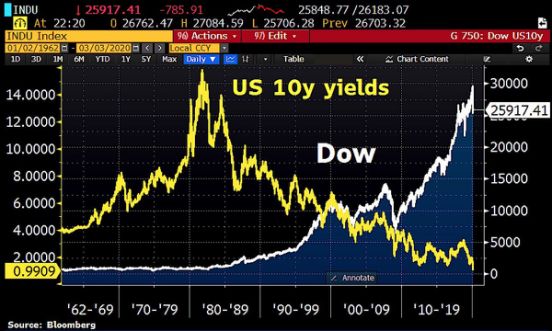
Data source: Bloomberg
In a long period of "paradigm" in the past, investors were excited when they heard of interest rate cuts, often equating water releases and asset bubbles. It is true that lowering the interest rate of the central bank can lower the risk-free interest rate, which will increase the discounted present value of assets and increase asset prices.
However, the current interest rate adjustment policy of the US Federal Reserve is about to come to an end after the monetary policies of Europe and Japan have failed. The impact of interest rate cuts on the rise in asset prices has weakened marginally, and the impact of interest rate cuts on the rise in asset prices has been relatively reduced. At the same time, different from previous financial market crises, this risk stems from the damage caused by viruses to the real economy. Once the damage continues to deepen, central banks and ammunition depots in various countries have become empty. In the context of high asset valuations and higher leverage For many countries, the probability that interest rate cuts will cause instability has begun to outweigh the possibility that interest rate cuts will stimulate a new round of asset bubbles.

Image source: Internet
In contrast, China has repeatedly cut interest rates and lowered its standard since 2019. Although the yield on the 10-year Treasury bond has fallen to its low in 2016, there is still a lot of policy space in nominal terms. The RMB exchange rate has also risen sharply, and investors may have felt this from the sharp fall in USDT. In February, China ’s manufacturing PMI fell to 35.7, which was lower than the 38.8 when the financial crisis broke out in November 2008. The People ’s Bank of China continued to cut interest rates and lower standards, and launched a trillion-level “new infrastructure” stimulus to continue to relax the “flexible currency” "Combining policies with active fiscal policies" is basically a clear sign. China's stock market and bond market will have a large upside in this space. This is also the main reason why foreign capital continues to chase China's financial assets and lead to double-buy stocks and bonds. .
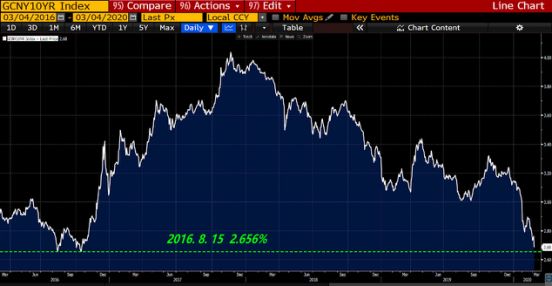
Data source: Bloomberg
The new crown pneumonia epidemic has evolved into an expanding global public health crisis. The spread of the epidemic will deepen the downward trend of economic growth. It is not yet possible to predict the persistence and severity of the epidemic ’s impact on overseas countries. At present, interest rate cuts are only in response to the spread of the first wave of epidemics. The impact of the epidemic on the overseas real economy will release a second wave of shocks, and subsequent results are incalculable.
However, the response to short-term financial market fluctuations has exhausted the central bank ’s interest rate tools. Under such conditions, we are likely to see the nominal interest rates of central banks in the United States compress to zero. The big meal belongs to QE (quantitative easing) and fiscal deficit monetization. Governments of all countries must end in person to stimulate aggregate demand through government spending . However, the size of government debt is already quite large, and deficits and interest expenses are tight. Therefore, the government wants to further issue national debt. To increase the deficit rate, the central bank must also issue notes to purchase government bonds, refinance the government with low costs, stimulate aggregate demand and guide the depreciation of the US dollar, thereby promoting upward inflation and realizing a closed loop of real debt reduction-which also means that real interest rates are constantly increasing. Looking down, this is also the direction that Europe and Japan are continuously advancing, and it will also be the trend of convergence of countries around the world .
Following this path, the next phase of asset allocation will obviously encounter three mountains:
1) Low economic growth has become the ceiling for low returns on assets, and at the same time may face the pressure of high inflation;
(2) The decline in long-term real interest rates and the proliferation of liquidity have pushed up the valuation of large-scale assets and suppressed the risk premium;
C) It is affected by the first two points. The funds strive to squeeze all possible high returns, resulting in very high transaction congestion and potential price volatility. Therefore, the key to future investment is to choose to resist the decline in real interest rates. Risk premium potential. Currently, institutions and individuals have severely underweighted investment products.
New low interest rates, where funds hold together
Gold is a very good choice. As can be seen from the actual gold interest rates (coordinate switching between positive and negative) of gold and US 30-year Treasury bonds shown below, gold can not be narrowly defined as "hedged assets", and gold is stored as value. For tools and commodities, gold and the US real interest rate have had a perfect negative correlation over the past three decades. As the real interest rate has fallen, the price of gold has continued to rise, and it will still have a very broad allocation space in the future.

Data source: Bloomberg
If there are better options than gold, it is none other than Bitcoin. Bitcoin, like gold, is an interest-free asset, and has become more attractive to investors in the era when major global economies have generally entered negative interest rates. Therefore, Bitcoin and gold also have the property of resisting the decline in real interest rates. In a long-term environment of low-cost funds and abundant liquidity, smart funds will be financed through ultra-low interest rates, and seek to squeeze as much as possible on the high-risk premium assets such as Bitcoin. The asset portfolio is in a clearly underweight position, and asset allocation funds will continue to drive up prices and expected positive feedback, becoming an important driving force for the price of Bitcoin in this economic environment. Recently, India's Supreme Court announced the reversal of the previous ban on cryptocurrency transactions and South Korea's parliament passed a special financial law to give a green light to the crypto asset exchange license system. The two news items undoubtedly indicate that Bitcoin will welcome a new posture of global investors.
In addition to the situation in the Middle East, the global epidemic, the US presidential election and other "black swan" events shrouded in investors' heads, the "grey rhino" in the room is stepping down and approaching the interest-rate and debt-driven since 1981 The global economic and financial environment. Major economies have been in a negative or even zero and negative interest rate environment for a long time, encouraging the debt behavior of governments, enterprises and individuals, and global debt has grown like a snowball. Today, 94% of the U.S. society's money supply is driven by debt creation. The annual increase in GDP in the United States is exactly the same as the interest payable in the United States that year. The four sectors of the national economy have been firmly bound by high debts. Go further and further down the road to lower interest rates. With interest rates falling and debt levels still rising, the current Fed Chairman Powell is unable to cope with pressure from the president and the market. Through quantitative easing and monetization of fiscal deficits, the use of banknote printing to provide cheap large-scale financing for government debt and control of bonds The yield curve is already an inevitable last resort, so it is said that interest rate cuts are only an appetizer, QE is a big meal, and the global water release competition is just getting better.
The financial cornerstones of the contemporary world are facing unprecedented tests. The industry once had a joke saying that U.S. stocks, JGBs, China Real Estate and Deutsche Bank are the four major global bubbles. It is not known that Deutsche Bank is already facing bankruptcy, and US stocks are in a sharp fall crisis caused by the epidemic. Japanese bonds are also undergoing research on the devaluation of the US dollar and the appreciation of the Japanese yen. Can investors still think that the "gray rhino" is still far behind, as they have been fortunately in the past two decades? If the world really has a serious economic recession and debt crisis in the complicated "black swan" incident-"Gray Rhino", can investors then think of the "Safe Box" digital gold bitcoin of the global financial and monetary system?
Judging from the secondary market price performance, Bitcoin has undergone a 45-day unilateral rise from January 2020 and is currently in the process of consolidation. It can only be adjusted at least until mid to late March. The monthly market will be the most important turning point of the market in 2020-2021.
The figure below shows the weekly and monthly logarithmic trend of bitcoin. From the figure, it can be clearly seen that bitcoin is running towards the end of the finishing triangle regardless of the weekly level or the monthly level. It is expected that the breakthrough direction will be selected at the end of April. A breakthrough can form a long-term cow for more than one year .
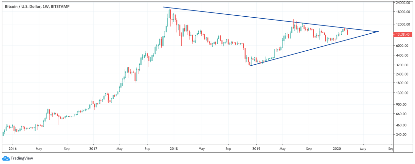
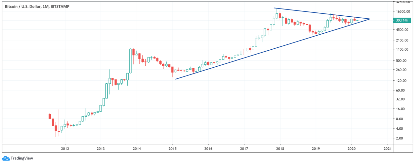
Data source: Tradingview BlockVC strategy research
In the short term, the price of bitcoin has begun to approach the center of the finishing triangle. Because the $ 8,500 line is a platform that has been repeatedly tested in the early stage, the support is considerable. The shock has bottomed out, and it has regained its uptrend in the future, and it may even complete an upward breakthrough by halving the approaching trend.
The forthcoming global central bank's QE wave is a new round of huge transfers and redistributions of global wealth. For funds with a higher risk appetite and the pursuit of high yields, Bitcoin is the best choice for investment allocation. Bitcoin It will truly usher in its own era. In the current trend at the end of the monthly and weekly consolidation, investors do not need to make a "bull gone" or "bear come" judgment on the one-thousand-dollar fluctuation. BlockVC strategy research believes that market-driven logic is clearer from The "half bull" has evolved towards the loose "buffalo" of the global currency, and this is the underlying soil for the growth of bitcoin. A long-awaited long-term bull is determined to win.
At that time, you will recall the sentence left by Satoshi Nakamoto in the Bitcoin genesis block in this tide of global interest rate cuts that began in March 2020:
The Times 03 / Jan / 2009 Chancellor on brink of second bailout for banks (On January 3, 2009, the Chancellor was on the verge of implementing the second round of emergency bank assistance).
We will continue to update Blocking; if you have any questions or suggestions, please contact us!
Was this article helpful?
93 out of 132 found this helpful
Related articles
- Exchange service provider AlphaPoint raises $ 5.6 million, Galaxy Digital takes another shot
- Loss of $ 98 billion per year! Nike, CK, Tommy Hilfiger seek to use blockchain technology to tackle counterfeiting
- Japan-Korea exchange stolen, U.S. sanctions Chinese OTC money changer? 3800BTC transaction reveals the process behind
- Market analysis: market trading sentiment has recovered, and the bulls have begun to exert their strength?
- World Economic Forum: Can the blockchain get rid of the speculation in 2020?
- Top conversation! Coinbase CEO's Fireside Talk with A16z Founder: Blockchain and the Internet Resemble Each Other
- Viewpoint | Reveal the truth of Bitcoin's "halving market", will history really repeat itself?




